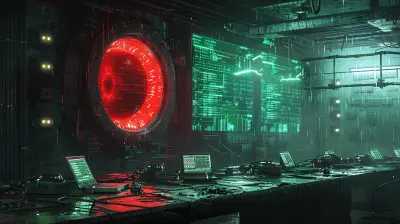22 March 2025
If you've ever dabbled in photography, you've likely come across the term "focal length." Sounds technical, right? But here's the thing: understanding focal length is essential if you want to take your photography skills up a notch. Whether you're snapping portraits, landscapes, or even experimenting with macro shots, knowing how focal length impacts your shots can make all the difference.
In this article, we're going to dive deep into focal length, its effects on your photos, and how different lenses can transform your images. By the end, you'll not only understand focal length but also how to choose the right lens for the perfect shot. Ready? Let’s get started!

What is Focal Length?
Let’s break it down. Focal length is essentially the distance between the lens and the camera sensor when the subject is in focus. It’s measured in millimeters (mm), and it plays a significant role in determining how much of the scene you can capture and how your subject will appear in the frame.Think of it like this: focal length is like the zoom function in your brain. The more you zoom in (longer focal length), the narrower your field of view becomes, and the closer your subject appears. The more you zoom out (shorter focal length), the wider your field of view, and the smaller the subject looks relative to the background.
Focal Length and Field of View
One of the most important things to understand about focal length is how it affects the field of view. The field of view refers to how much of the scene in front of you is captured in the photo. A shorter focal length (like 18mm) will give you a wider field of view, which is great for capturing broad landscapes or large groups of people. On the other hand, a longer focal length (like 200mm) will give you a much narrower field of view, perfect for isolating subjects and bringing distant objects closer.You can think of focal length as the equivalent of your own vision. When you're looking at something up close, you're focusing on the details, and everything around it blurs into the background. That’s what happens with a long focal length. Conversely, when you look at a vast landscape, your attention is spread across the entire scene. This is what happens with a short focal length.

Types of Lenses and How They Impact Your Shots
Different lenses come with varying focal lengths, and each type of lens produces a distinct effect on your photos. Let’s go over the most common categories of lenses and how they impact your shots.1. Wide-Angle Lenses (14mm - 35mm)
Wide-angle lenses are pretty straightforward: they allow you to capture a wider scene. These lenses typically have a focal length of 35mm or lower, with the most extreme wide-angle lenses going down to 14mm or even lower. They’re the go-to choice for landscape photographers or anyone trying to capture a vast scene in one frame.But here's the catch: while wide-angle lenses allow you to fit more into your shot, they can also distort the image. Ever noticed how things look stretched or curved at the edges in some photos? That’s wide-angle lens distortion. This effect can be used creatively, but it’s something to keep in mind, especially when shooting portraits (unless you want your friend's face to look like it's trapped in a funhouse mirror).
Ideal For:
- Landscapes- Architecture
- Group shots
- Interiors (when space is tight)
Not Ideal For:
- Portraits (unless you're going for an artistic, distorted look)2. Standard Lenses (35mm - 70mm)
Standard lenses, also known as normal lenses, fall between 35mm and 70mm focal lengths. These lenses tend to capture images that are closest to what our eyes naturally see. They don’t have the exaggerated wide-angle distortion, and they aren’t zoomed in like telephoto lenses.If you’re looking for versatility, a standard lens is your best bet. It’s great for just about anything—portraits, street photography, and general-purpose shooting. The 50mm lens, in particular, is often referred to as the "nifty fifty" because of its versatility and sharpness. It’s a must-have in any photographer’s kit.
Ideal For:
- Street photography- Portraits
- Everyday shooting
- Travel photography
Not Ideal For:
- Distant subjects- Ultra-wide landscapes
3. Telephoto Lenses (70mm - 300mm)
Telephoto lenses have longer focal lengths and are designed to bring distant objects closer to the camera. If you’re trying to capture close-up shots of wildlife, sporting events, or any subject far away, telephoto lenses are your go-to.The downside? These lenses tend to have a much narrower field of view, and they can be heavy and cumbersome to carry around. Telephoto lenses also make it harder to keep your shot stable, so you may need to use a tripod, especially if you're shooting with a really long focal length (think 200mm+).
Ideal For:
- Wildlife photography- Sports photography
- Portraits with beautiful background blur (bokeh)
Not Ideal For:
- Landscapes- Indoor shots (due to limited field of view)
4. Prime Lenses vs. Zoom Lenses
Now, there’s another distinction you need to know: prime lenses vs. zoom lenses. Prime lenses have a fixed focal length, meaning you can’t zoom in or out. While this might sound limiting, prime lenses are often sharper and offer better image quality than zoom lenses. Plus, they tend to have larger apertures (which means better performance in low-light conditions).Zoom lenses, on the other hand, let you adjust the focal length. This makes them more versatile, as you can change your composition without physically moving. However, zoom lenses tend to be bulkier and may not be as sharp as prime lenses.
Prime Lens Pros:
- Sharper images- Larger apertures (better for low-light)
- Lighter and more compact
Zoom Lens Pros:
- More versatile- No need to swap lenses for different focal lengths

How Focal Length Affects Composition
Beyond the technicalities, it’s important to understand how focal length impacts your composition. The focal length you choose can dramatically change the way your subject looks in the frame, as well as the relationship between the subject and its surroundings.1. Perspective Compression (Long Focal Lengths)
When you use a long focal length (telephoto), you’ll notice something interesting: objects in the background appear closer to your subject than they actually are. This phenomenon is called "perspective compression." It’s particularly useful in portrait photography because it helps isolate your subject and blur the background, creating a more flattering and focused image.2. Exaggerating Perspective (Short Focal Lengths)
On the flip side, wide-angle lenses exaggerate perspective. Objects closer to the lens will appear much larger, while those in the background will seem much smaller. This effect can make your shots feel more dynamic and dramatic. It’s often used in landscape photography to create a sense of depth and scale.3. Depth of Field Changes
Focal length also affects the depth of field (DoF). When you use longer focal lengths, the depth of field becomes shallower, meaning only a small portion of your image will be in focus, while the rest will blur out. This is perfect for portraits or macro photography, where you want to draw attention to your subject and blur the background.On the other hand, shorter focal lengths tend to have a deeper depth of field, meaning more of your image will be in focus. This is ideal for landscapes or architectural shots where you want everything to be crisp and clear.

How to Choose the Right Focal Length for Your Shots
So, how do you choose the right focal length for your shots? It all boils down to what you’re trying to achieve. Here are some quick tips:- For landscapes: Go with a wide-angle lens (14mm-35mm) to capture the vastness of the scene.
- For portraits: A standard or telephoto lens (50mm-135mm) will give you flattering results with a nice bokeh effect.
- For wildlife or sports: You’ll want a long telephoto lens (200mm-400mm) to get up close without disturbing your subject.
- For street photography or everyday shooting: A standard lens (35mm-50mm) is versatile and great for capturing natural, candid moments.
Conclusion
Focal length is more than just a number—it’s a powerful tool that can drastically impact your photos. From capturing sweeping landscapes with a wide-angle lens to isolating your subject with a telephoto lens, understanding how focal length affects your shots will help you take your photography to the next level.The key takeaway? Don’t be afraid to experiment with different lenses and focal lengths. Each one offers its unique perspective and creative possibilities. Once you grasp how focal length changes the look and feel of your images, you’ll be able to make more informed decisions and capture the shots you’ve always envisioned.






Kenna McAuley
Great article! Understanding focal length truly enhances photography skills. Excited to explore how different lenses can elevate my shots!
April 1, 2025 at 12:45 PM